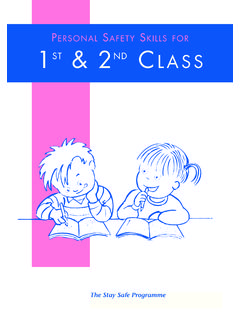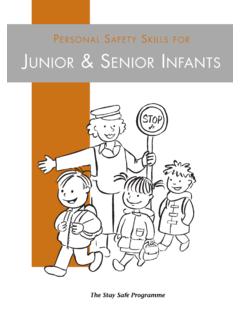Transcription of Latin American Folktales - Denver Public Schools
1 El Alma de la Raza ProjectThreeLatin AmericanFolktalesDenver Public SchoolsIn partnership with Metropolitan State College of DenverThreeLatin AmericanFolktalesBy Nina DaughertyGrades K 1 Implementation Timefor Unit of Study: 3 weeksEl Alma de la Raza SeriesDenver Public SchoolsEl Alma de la Raza Curriculumand Teacher Training ProgramLoyola A. Martinez, Project DirectorEl Alma de la Raza Series. 2001 Denver Public Schools1 Three Latin American FolktalesThree Latin American FolktalesUnit Concepts Storytelling Immigration Characterizations GeographyStandards Addressed by This UnitReading and WritingStudents read and understand a variety of materials. (RW1)Students write and speak for a variety of purposes and audiences. (RW2)Students write and speak using formal grammar, usage, sentence structure,punctuation, capitalization, and spelling. (RW3)Students apply thinking skill to their reading, writing, speaking, and viewing.
2 (RW4)GeographyStudents know how to use and construct maps and other geographic tools to locate andderive information about people, places, and environments. (G1)Students know the physical and human characteristics of places and use this knowledgeto define and study regions and their patterns of change. (G2)Visual ArtsStudents recognize and use the visual arts as a form of creativity and communication.(VA1)Students know and apply elements of art, principles of design, and sensory expressive,and creative features of visual arts. (VA2)IntroductionIn Latin American Folktales , as in Folktales throughout the world, children of Latin decent willbe introduced to characters who reflect their own diverse culture. All children need strong rolemodels to give them a broader perspective and validate their experiences. These three LatinAmerican tales are authentic connections to their lives. This validation is important not only forLatino children, but to help individuals from all cultures enjoy and learn from the evolved over the centuries from storytelling.
3 The oral tradition offered entertainment,recounted history, and explained the unexplainable. Additionally, morals and the social valuesof a culture could be taught in a subtle manner allowing the listener to draw his or her ownconclusions. The mysterious, miraculous, and the unknown engage even the youngestlisteners. Magical forces enable the heroes and heroines to combat injustice and evil. Charactersand their accompanying problems, whether animals or human, frequently are depicted asEl Alma de la Raza Series. 2001 Denver Public Schools2 Three Latin American Folktaleseveryday beings found in all societies. Participants, therefore, can freely relate to theadventures and enjoy the world of fantasy while stimulating their Folktales found in this unit are included because the characters are, for the most part,ordinary people or animals. These characters are going about their daily lives when theunexpected occurs or mistakes are made.
4 These mistakes and occurrences are easily identifiableby the students, allowing them to make inferences about the outcomes. In The Gentle People, for example, a member of the community unwittingly ventures into the forbidden forest. Thiscauses an unfortunate chain of events and consequences for his tribe. In this tale, and in TheSearch for the Magic Lake, a monarch plays a part in the outcome. An average citizen,however, plays the pivotal GuidelinesThis unit has been developed for kindergarten and first-grade students. Lessons have beencreated so that children of diverse backgrounds and ability levels can participate attention is paid so that English Language Learners can expand oral and writtenvocabulary, syntax, and grammar. The three Folktales included here are Latin American inorigin. The learner will achieve a fuller exposure to the history, culture, and diversity of theLatin American part of the culmination of this unit, it is recommended to invite parents to come to the finalclass and prepare to share a folktale that had been passed down to them.
5 Send home the letteron page 25 and with the Family History Form (on page 26) at the beginning of Lesson 5 (orsooner) so that parents can plan to Alma de la Raza Series. 2001 Denver Public Schools3 Three Latin American FolktalesInstructional Materials and ResourcesThe following resources are needed for implementing this unit:Lesson 1 Lesson 1 Lesson 1 Lesson 1 Lesson 1 Large chart paperMarkers Medio Pollito, and other Folktales the teacher has in her/his room, The Three LittlePigs, Los Tres Peque os Jabal es The Three Little Javalinas, Momentos M gicos Magic Momentsby Olga Loya, Pre-Columbian Stories by Robert HullLesson 2 Lesson 2 Lesson 2 Lesson 2 Lesson 2 Medio Pollito from Se or Cat s Romance by Luc a M. Gonz lezDiego by Jonah WinterButcher paperChart made in Lesson 1 Template for components of the storyCrayons or markersLesson 3 Lesson 3 Lesson 3 Lesson 3 Lesson 3 Medio Pollito from Se or Cat s Romance by Luc a M.
6 Gonz lezThe Unicorn of the West by Alma Flor AdaTemplate for weather vane of Medio PollitoScissorsPopsicle sticksCrayonsLesson 4 Lesson 4 Lesson 4 Lesson 4 Lesson 4 The Gentle People from Tales Alive! Ten Multicultural Folktales With Activities by Susan MilordHe Llama s Secret: A Peruvian Legend by Argentina PalaciosFlip Book: three pieces each of blank paper to make each child s book (template included)StaplerCrayonsChart paper for large Venn diagramLesson 5 Lesson 5 Lesson 5 Lesson 5 Lesson 5 Letter to parents requesting family informationFamily history worksheet to send home with each childLarge world mapGlobe The Search for the Magic Lake from Tatterhood and Other Tales edited by Ethel Johnston PhelpsButcher paper for the Stair-Step Story MapStair-step worksheets one for each childFour pieces of butcher paper; each a different color and about five-feet longTwo six-foot lengths of blue butcher paper (for the ocean)One six-foot length of brown butcher paper (for the continents)One four-foot length of white butcher paper (for Antarctica and the polar ice cap of thenorth pole)El Alma de la Raza Series.
7 2001 Denver Public Schools4 Three Latin American FolktalesOne six-foot length of yellow butcher paper for creating large national maps to overlay onthe floor map: Spain, Peru, Argentina, the United States, and MexicoThree pieces of chart paperMarkersCrayonsLesson 6 Lesson 6 Lesson 6 Lesson 6 Lesson 6 Medio Pollito from Se or Cat s Romance by Luc a M. Gonz lez, The Gentle People from Tales Alive! Ten Multicultural Folktales With Activities by Susan Milord The Search for the Magic Lake from Tatterhood and Other Tales edited by Ethel Johnston PhelpsThree pieces of large chart paper, markersThe Dancing Turtle, A Folktale from Brazil by Pleasant De Spain (optional)Lesson 7 Lesson 7 Lesson 7 Lesson 7 Lesson 7 Template for masksScissorsCrayonsGlueFlip booksMurals and wall chartsOther craft items for decorating the masks Medio Pollito from Se or Cat s Romance by Luc a M. Gonz lez The Gentle People from Tales Alive! Ten Multicultural Folktales With Activities by Susan Milord The Search for the Magic Lake from Tatterhood and Other Tales edited by Ethel Johnston PhelpsLesson 8 Lesson 8 Lesson 8 Lesson 8 Lesson 8 Medio Pollito from Se or Cat s Romance by Luc a M.
8 Gonz lez The Gentle People from Tales Alive! Ten Multicultural Folktales With Activities by Susan Milord The Search for the Magic Lake from Tatterhood and Other Tales edited by Ethel Johnston PhelpsPlain white paper; one for each studentCrayons or markersMurals, charts, and other work done in previous lessonsOther craft supplies to decorate the masks or propsMultiple copies of the speaking/acting parts of various characters and narrators, from eachof the three 9 Lesson 9 Lesson 9 Lesson 9 Lesson 9 Completed family history worksheetsFloor or wall map from Lesson 6 MasksWall chartsFlip booksCopies of parts for charactersRefreshments (optional)El Alma de la Raza Series. 2001 Denver Public Schools5 Three Latin American FolktalesLesson SummaryLesson 1 Those Wonderful Folktales ! .. 6 Elements of a Folktale. Selected reading of Medio Pollito, retold by Luc a M. Gonz 2 Map-A-Story on a Mural .. 9 Components of a story are introduced.
9 Students learn to createa Story Map 3 Let s Make a Weather Vane .. 12 Students learn the four directions, and what information weget from weather vanes. Students construct a weather 4 The Gentle People .. 15 Read The Gentle People, learn sequence, and createsequence 5Oh! Where Are We? .. 21 Students learn maps, globe skills, and story 6 What Happens When? .. 28 Students learn Cause and Effect, chart the actions, events,decisions, and outcomes of the three literary 7 Those Wonderful Masks! .. 31 Mask Making and Drama Students make masks ofcharacters and/or events of the three tales and retell the 8I Am Powerful! .. 35 Students delve into magical powers and create illustrations ofhim/herself using magical 9We Are Family! .. 37 Families share histories and Alma de la Raza Series. 2001 Denver Public Schools6 Three Latin American FolktalesLesson 1:Those Wonderful Folktales !What will students be learning?
10 STANDARDSS tudents read and understand a variety of materials. (RW1)Students write and speak using formal grammar, usage, sentence structure, punctuation,capitalization, and spelling. (RW3)Students read and recognize literature as a record of human experience. (RW6)BENCHMARKSS tudents will use comprehension will apply formal usage in will read (listen to) classic literature representing various cultural and ethnictraditions from throughout the will identify Folktales as will use complete sentences when giving will use background knowledge to compare the folktale Medio Pollito to storiesthey already are stories told by common people that are often handed down through generationsof families. Some common characteristics of Folktales are that the characters often have magicalor supernatural powers that help them. Sometimes the characters are animals with humantraits, such as the ability to speak. Good often, but not always, triumphs over evil.


